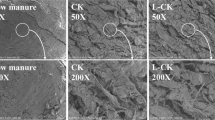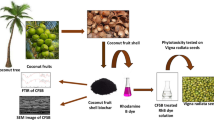Abstract
Removal of heavy metals (Pb2+, Zn2+) from aqueous solution by dried biomass of Spirulina sp. was investigated. Spirulina rapidly adsorbed appreciable amount of lead and zinc from the aqueous solutions within 15 min of initial contact with the metal solution and exhibited high sequestration of lead and zinc at low equilibrium concentrations. The specific adsorption of both Pb2+ and Zn2+ increased at low concentration and decreased when biomass concentration exceeded 0.1 g l−1. The binding of lead followed Freundlich model of kinetics where as zinc supported Langmuir isotherm for adsorption with their r 2 values of 0.9659 and 0.8723 respectively. The adsorption was strongly pH dependent as the maximum lead biosorption occurred at pH 4 and 10 whereas Zn2+ adsorption was at pH 8 and 10.




Similar content being viewed by others
Abbreviations
- Q:
-
Metal ion adsorbed per unit mass of Spirulina (mg g−1), at equilibrium
- V:
-
Volume of solution (l)
- Ci :
-
Initial concentration of metal ions in solution (mg l−1)
- Cf :
-
Final concentration of metal ions in solution (mg l−1)
- M:
-
Mass of biomass (g)
- qmax :
-
Langmuir parameter, maximum theoretical adsorption upon complete saturation of the surface (mg g−1)
- b:
-
Langmuir constant related to the energy of adsorption desorption (l mg−1)
- k:
-
Freundlich constant related to the strength of the adsorptive bond (mg1−n/g ln)
- n:
-
Freundlich constant related to bond distribution
References
Dudka S, Miller WP (1999) Accumulation of potentially toxic elements in plant and their transfer to human food chain. J Environ Sci Heal B 34:681–708
Volesky B (1994) Advances in biosorption of metals: selection of biomass types. FEMS Microbiol Rev 14:291–302
Ahluwalia SS, Goyal D (2007) Microbial and plant derived biomass for removal of heavy metals from wastewater. Bioresour Technol 98:2243–2257
Kim DW, Che DK, Wang J, Huang CP (2002) Heavy metal removal by activated sludge: influence of Nocardia amarae. Chemosphere 46:137–142
Zouboulis AI, Loukidou MX, Matis KA (2004) Biosorption of toxic metals from aqueous solution by bacterial strains isolated from metal-polluted soils. Process Biochem 39:909–916
Incharoensakdi A, Kitjaharn P (2002) Zinc biosorption from aqueous solution by halotolerant cyanobacterium Aphanotheca halophytica. Curr Microbiol 45:261–264
Yan G, Viraraghavan T (2003) Heavy-metal removal from aqueous solution by fungus Mucor rouxii. Water Res 37:4486–4496
Oswald WJ (2003) My sixty years in applied algology. J Appl Phycol 15:99–106
Pavasant P, Apiratikul R, Sungkhum V, Suthiparinyanont P, Wattanachira S, Marhaba TF (2006) Biosorption of Cu2+, Cd2+, Pb2+, and Zn2+ using dried marine green macroalga Caulerpa lentillifera. Bioresour Technol 97:2321–2329
Polti MA, Amaroso MJ, Abate CM (2007) Chromium(IV) resistance and removal by actinomycete strains isolated from sediments. Chemosphere 67:660–667
Xiong J, He Z, Liu D, Mahmood Q, Yang X (2008) The role of bacteria in the heavy metals removal and growth of Sedum alfredii Hance in an aqueous medium. Chemosphere 70:489–494
Ahluwalia SS, Goyal D (2007) Microbial and plant derived biomass for removal of heavy metals from wastewater. Bioresour Technol 98:2243–2257
Dönmez G, Aksu Z (2002) Removal of chromium(VI) from saline wastewaters by Dunaliella species. Process Biochem 38:751–762
Davis TA, Volesky B, Mucci A (2003) A review of the biochemistry of heavy metal biosorption by brown algae. Water Res 37:4311–4330
Chojnacka K, Chojnacki A, Górecka H (2004) Trace element removal by Spirulina sp. from copper smelter and refinery effluents. Hydrometallurgy 73:137–153
Mehta SK, Gaur JP (2005) Use of algae for removing heavy metal ions from wastewater: progress and prospects. Crit Rev Biotechnol 25:113–152
Kratochvil D, Volesky B (1998) Advances in the biosorption of heavy metals. Trends Biotechnol 16:291–300
Gong R, Ding Y, Liu H, Chen Q, Liu Z (2001) Lead biosorption and desorption by intact and pretreated Spirulina maxima biomass. Chemosphere 58:125–130
Hong C, Shan-shan P (2005) Bioremediation potential of Spirulina toxicity and biosorption studies of lead. J Zhejiang Univ Sci B 6:171–174
Volesky B (1992) Removal of heavy metals by biosorption. In: Ladisch MR, Bose A (eds) Harnessing biotechnology for the 21st Century. Amer Chem Soc, Washington DC, pp 462–466
Zhang L, Zhao L, Yu Y, Chen C (1998) Removal of Pb2+ from aqueous solution by non-living Rhizopus nigricans. Water Res 32:1437–1444
Langmuir I (1918) The adsorption of gases in plain surface of glass, mica, and platinum. J Am Chem Soc 40:1361–1403
Freundlich H (1907) Uber die adsorption in lousumgen. Z F Phys Chem 57:385–471
Solisio C, Lodi A, Soletto D, Converti A (2008) Cadmium biosorption on Spirulina platensis biomass. Bioresour Technol 99:5933–5937
Parent L, Campbell PGC (1994) Aluminium bioavailability to the green alga Chlorella pyrenoidosa in acidified synthetic soft water. Environ Toxicol Chem 13:587–598
Aksu Z, Kutsal T (1990) Comparative study for biosorption characteristic of Zn ion with C. vulgaris. Environ Technol 11:979–987
Chojnacka K, Chojnacki A, Górecka H (2005) Biosorption of Cr3+, Cd2+ and Cu2+ ions by blue-green algae Spirulina sp: kinetics, equilibrium and the mechanism of the process. Chemosphere 59:75–84
Mehta SK, Gaur JP (2001) Removal of Ni and Cu from single and binary metal solution by free and immobilized Chlorella vulgaris. Eur J Protistol 37:261–271
Volesky B (1990) Removal and recovery of heavy metals by biosorption. In: Volesky B (ed) Biosorption of heavy metals. CRC Press, Boca Raton, pp 7–43
Kojima H, Lee KY (2001) Photosynthetic microorganisms in environmental biotechnology. Springer-Verlag, Hong Kong
Sandau E, Sandau P, Pulz O (1996) Heavy metal sorption by microalgae. Acta Biotechnol 16:227–235
Acknowledgments
The authors thank the Director, Thapar University, Patiala, India, for providing the infrastructure and facilities and to University Grant Commission for providing the financial support vide Approval F-3-16/2002 (SR-II), dated March 16, 2002.
Author information
Authors and Affiliations
Corresponding author
Rights and permissions
About this article
Cite this article
Aneja, R.K., Chaudhary, G., Ahluwalia, S.S. et al. Biosorption of Pb2+ and Zn2+ by Non-Living Biomass of Spirulina sp.. Indian J Microbiol 50, 438–442 (2010). https://doi.org/10.1007/s12088-011-0091-8
Received:
Accepted:
Published:
Issue Date:
DOI: https://doi.org/10.1007/s12088-011-0091-8




